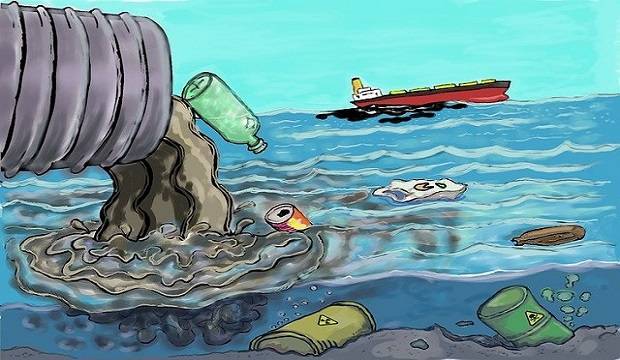Certain types of organic, inorganic and radioactive substances are present in the industrial waste in minute suspended or colloidal form and microorganisms pollute the source of water, where these are disposed of. The decomposition of industrial wastes by microorganisms results in products that are odoriferous or unacceptable in taste and appearance as well as harmful to public health.
The organic impurities give odour colour and taste to the water, whereas inorganic compounds give foaming, odour, turbidity, etc. Various types of bacteria, viruses and plant life also grow in the industrial/trade wastes.
Organic compounds such as proteins, carbohydrates, fats, dyes, tar, detergents etc. present in waste are objectionable.
Keratin from wool industries, proteins from egg albumen, tannin from tanneries, casein from dairies etc.

undergo degradation by bacterial action resulting in compounds that impart the most objectionable colour and pollute the water.
The pollutants add colour, taste and odour in the receiving water, making the water oily, greasy, corrosive and unfit for industrial, recreational or domestic use.
SEW They also impart a hardness, change pH-value, increase temperature and algal to growth, destroy the aquatic life and increase the insect nuisance.
What are the permissible limits of industrial effluent to be discharged into streams?
According to IS: 2490-1963 the industrial effluent allowed for discharge into the watercourses should have the following standards
1. 5day BOD at 20°C of effluent to be discharged into inland surface water as 30mg/l. In exceptional cases the BOD may be allowed up to 100mg/l
2. as far as possible and practicable, it should be free from colour and unpleasant odour
3. its pH-value should be between 5.5 to 9.0
4. from the outlet up to 15m downstream, the temperature should not be more than 40°C in any section of the stream,
5. oil, grease, phenolic compounds, cyanides (as CN) and sulphides (as S) should not exceed 10.0, 1.0, 0.2 and 2.0mg/l respectively,
6. total suspended solids should not exceed 100mg/l
7. presence of arsenic, barium, cadmium, chromium, copper, mercury, lead, selenium, nickel, silver and zinc should not exceed 1.0mg/l individually or collectively.
8. total residual chlorine and fluorides (as F) should not exceed 1.0 and 2mg/l respectively, and
9. radioactive materials like a, and B emitters should not exceed 10 and 10 pc/ml, respectively.
Discuss what points should be kept in mind while preparing cattle shed?
The cattle shed to protect the animals from rain, wind, heat and cold.
While designing the shed consideration should be given to the comfort and health of animals, the economic use of labour while feeding, cleaning and hygienic conditions for milk production.
Shed for animals should be built in an open well-drained site with further scope for expansion.
It should be easily accessible. Use of trees as windbreak or planting of quick-growing trees near the shed is recommended.
A moderate floor slope helps drainage of animal feed and dung. The site should be oriented east to west if possible.
What are the basic designing criteria for cattle sheds?
A stall of 1.5 m in length and 1.2 m in width is considered suitable for Indian cows.
Mangers and gutters should be of 0.75 m and 0.45 m wide, respectively, with all corners rounded by cement.
The entire construction should have no projections to scratch and tear the skin, legs or udder, nor should any part of the shed be favourable for the accumulation of dust.
The cattle shed should be close to the farmer’s house in order to attend to the animals at night time and in bad weather.
The site should have a good water supply. The conventional cattle sheds have roof of ordinary chappar, thatch work or flat roofs made with timber and earth.
The floor of the shed may be a bed of broken bricks, gravel, sand, lime and coal cinders well rammed to make a compact layer of over 15 cm thickness.
Stables for horses, pens for sheep and goats, sties for swine, kennels for dogs and sheds for camels, and other animal habitations should generally conform to basic hygienic principles.
Industrial Wastewater Solution | Low Cost Water Treatment Technology | Corporate Video Production
Discuss livestock hygiene.
Good hygienic conditions are the most important aspect of livestock farming. Proper hygienic conditions also prevent many diseases and disorders in the animals.
Livestock hygiene identifies the causes of all preventive animal diseases and devises means of removing those causes or rendering them ineffective.
It aims at increasing the efficiency of animals by providing them with the most comfortable conditions of life. Cleanliness helps to preserve the health of animals.
It is necessary that the animals should be frequently and systematically cleaned. Animal sheds must be kept clean and perfectly dry, especially the floors, managers and drains.
Solid and semi-solid excreta should be removed periodically from the sheds and put in proper manure pits.
The best time to wash and clean animal houses is when the animals are on grazing.
Sunlight and heat act as powerful disinfectants. Direct sun-rays kill many germs and mitigate the action by their oxidizing and desiccating properties.
Heat, as a disinfectant, may be applied either in the form of a direct flame or burning or steam of the boiling water.
Write short note on live stock management in organic farming
In Livestock Management in Organic Farming, the livestock should be taken proper care as
Cattle should be regularly washed and groomed once or twice a week.
The cattle should be washed once daily in hot weather, once a week during the rains, and once or twice a month during the cold weather. Suckling calves need not be bathed but should be brushed.
Feet should receive special attention in all animals, and any large dirt pieces of MORE SEE stone or thorn found lodged between the hoofs should be removed and sores properly cleaned.
Also, Read This